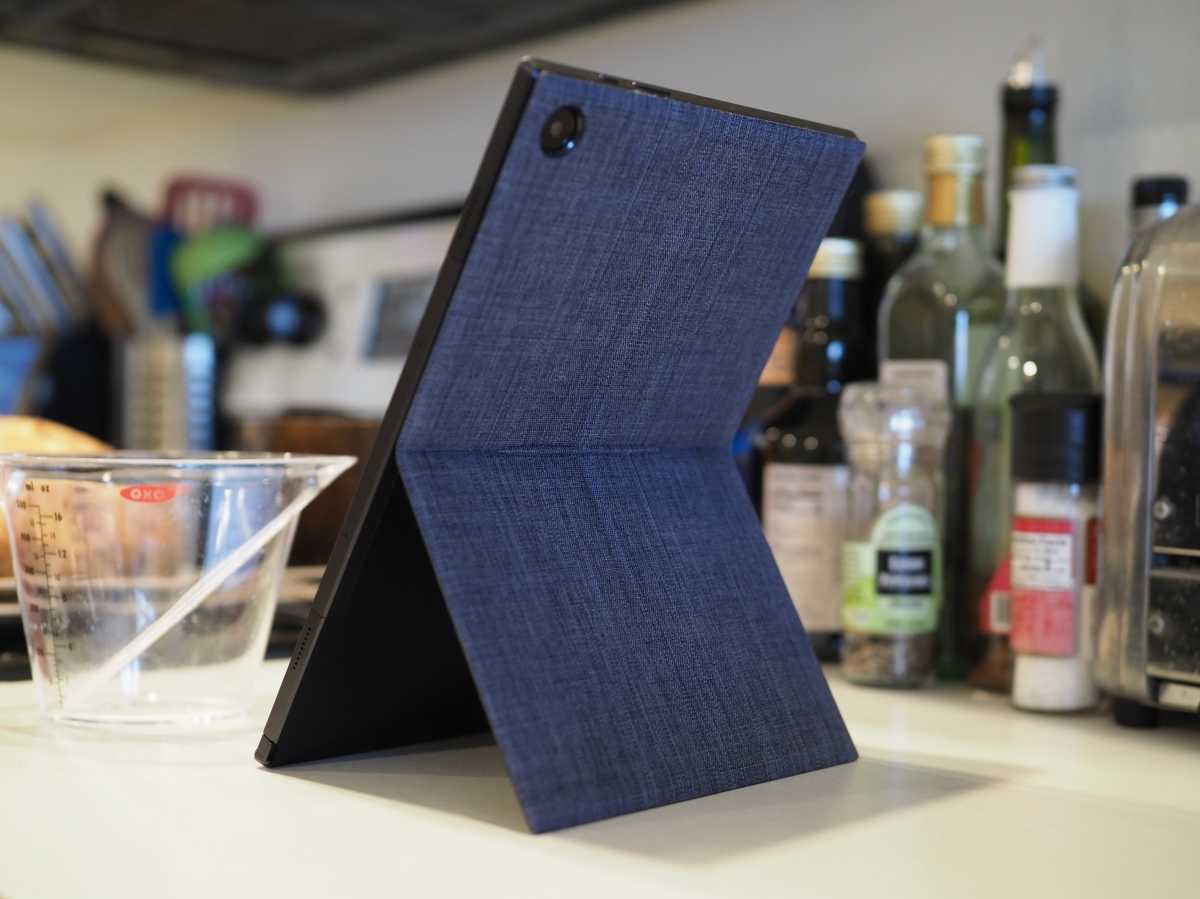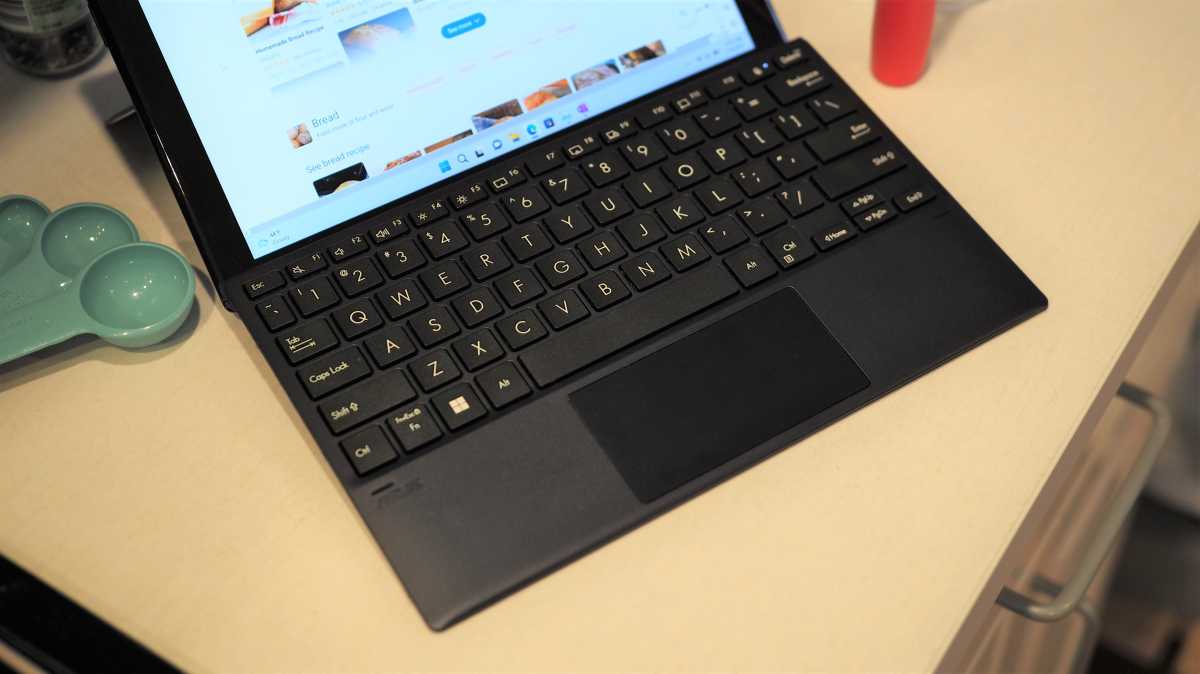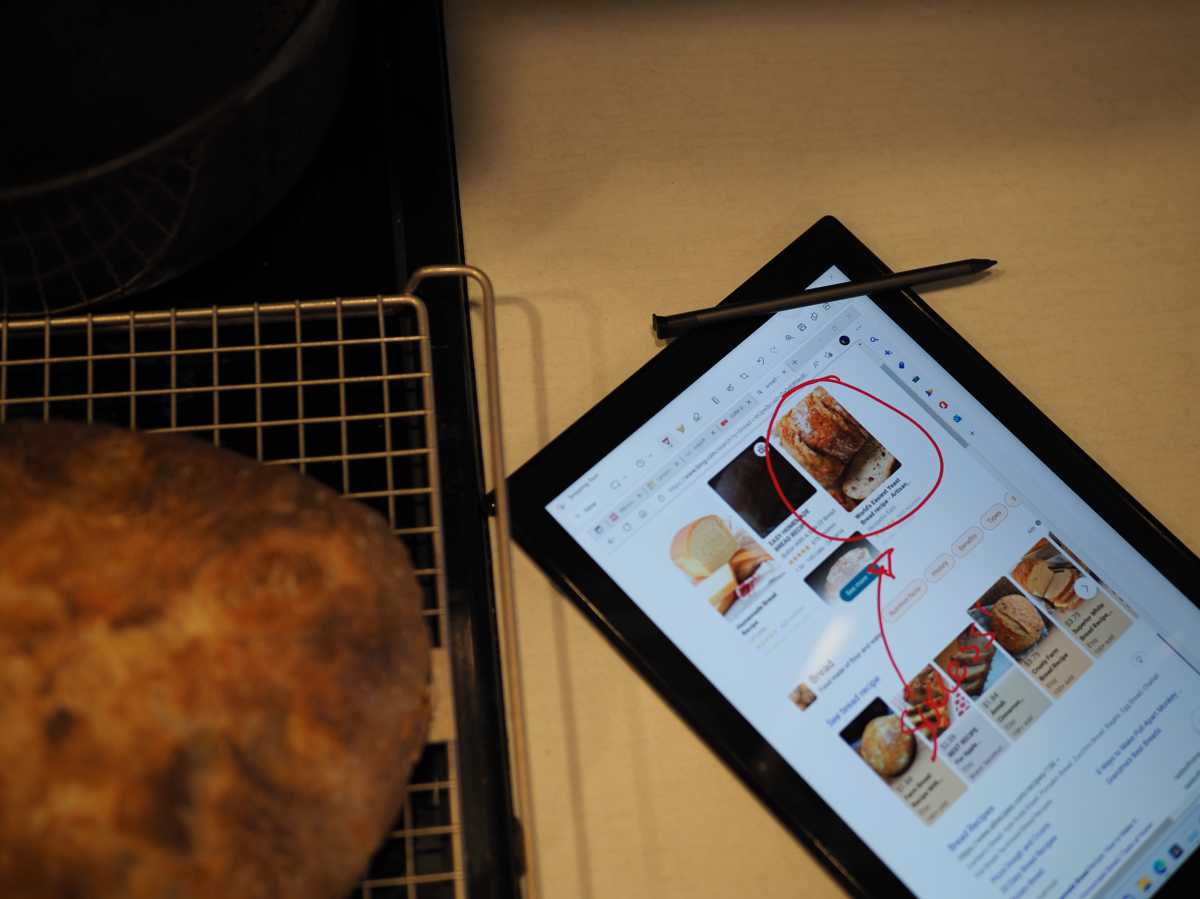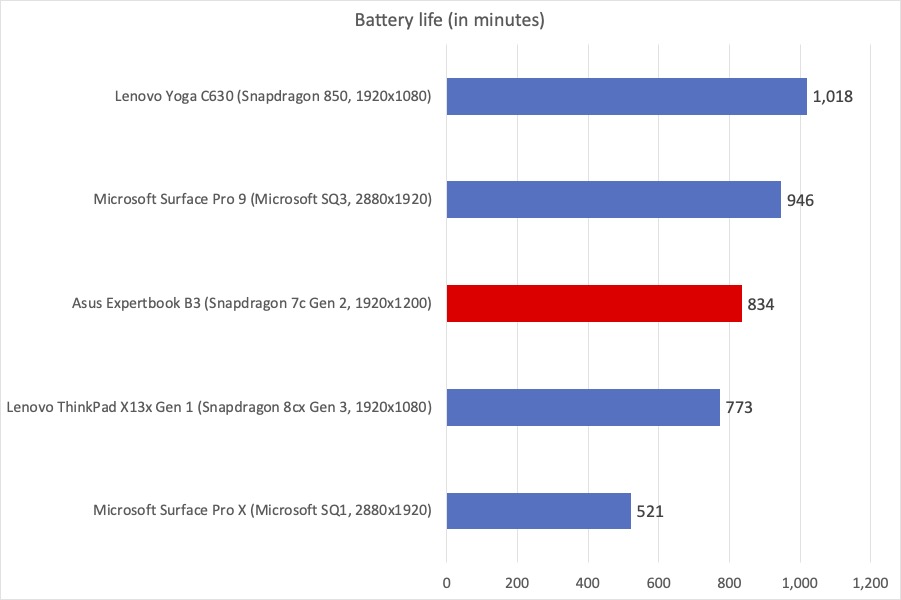Asus ExpertBook B3 review: A flexible PC that feels punishingly slow
Expert’s Rating
Pros
- Included keyboard and pen
- Nice display
- Long battery life
Cons
- Sluggish performance
- Limited connectivity
- Non-backlit keyboard
Our Verdict
The Asus ExpertBook B3 has a decent display and impressive battery life, but the sluggish performance really holds it back.
Price When Reviewed
$599.99
Best Prices Today: Asus ExperBook B3
$599.99
What can I say? I love a tiny computer. It seems like only yesterday that there were weird, cheap Windows machines galore, using small screens anywhere from 7 to 10 inches. Some of these tablets had active pens and almost all of them were incredibly slow or had a washed-out screen or some other terrible shortcoming. But, if you were willing to wait for their slow chips to chug along, they could be “good enough” in a pinch when running old apps or simple Office tasks.
That’s why the new Asus Expertbook B3 seemed so intriguing. Not only is this a small computer with a kickstand and a keyboard cover, it’s a tiny device with a pen that neatly tucks away into a silo. It’s even based on a newer Qualcomm Snapdragon 7c Gen 2 processor, which promises power-sipping, fanless operation. Can this little tablet overcome its modest spec sheet and give users a decent Windows 11 experience? In a word, no.
Asus ExperBook B3 specs and features
Our review unit came equipped with a Qualcomm Snapdragon 7c Gen 2 CPU, Adreno 618 graphics, 4GB of RAM, and 128GB of eMMC storage. Read on to learn more:
- CPU: Qualcomm Snapdragon 7c Gen 2 (8 cores)
- Memory: 4GB LPDDR4
- Graphics/GPU: Adreno 618 graphics
- Display: 10.5-inch IPS WUXGA (1920×1200) 16:10 touchscreen
- Storage: 128GB eMMC
- Webcam: 5MP front-facing/1080p for video
- Connectivity: 1x USB-C 3.2 Gen 1, 1x 3.5mm headset jack
- Networking: Wi-Fi 5, Bluetooth 5.1
- Digital Pen: MPP 2.0, charges from device
- Battery capacity: 38Wh
- Dimensions: 14.29 (W) x 9.36 (D) x 0.70 (H) inches
- Weight: 1.31 pounds (tablet-only), 2.22 pounds (tablet with keyboard and stand), 2.79 pounds with charger
- Price: $599.99
Design and build

IDG / Brendan Nystedt
Microsoft’s Surface basically invented the modern 2-in-1, putting the keyboard cover front-and-center and balancing the whole widget on a kickstand around the back. The ExpertBook B3 is a similar design, except the kickstand isn’t built-in. Instead, it’s a piece of fabric-wrapped plastic that attaches with magnets to the tablet. What this enables is a mode that lets you stand it up in vertical orientation, not just horizontally.
Unfortunately, I found the stand to be loosely connected except in its horizontal orientation with the keyboard attached. You certainly can’t use it as an easel for drawing with this stand–the angle it folds to is far too shallow to get it down to the tabletop. And then when you have it in vertical mode, there’s no way to connect the keyboard and the USB port is inaccessible, under the edge that’s facing the tabletop. I can see this degree of flexibility being helpful is you use your tablet in the kitchen as a cookbook, but otherwise it seems like a lot of engineering and bulk for an edge case.
At least Asus includes the kickstand attachment and keyboard cover in the box, so they’re not separate purchases. But the whole package feels a bit bulky when all put together, but the tablet on its own is impressively slim.
Connectivity
Given its small size, we can’t say we were surprised to find only two ports on this Asus tablet–a standard headset jack and a USB-C port. The USB-C port pulls double duty as your only charging port and the single option for I/O. At least there’s a huge market out there for dongles and hubs, making it simple to turn one port into a bunch of others, including display-out.
In terms of wireless capability, the B3 has Wi-Fi 5 and Bluetooth 5.1 as default, making it a bit behind the curve on Wi-Fi tech but totally usable for day-to-day tasks.
It would have been really nice to see a microSD card slot in this tablet as well, which can help make up for a lack of storage, but alas you’re stuck with the 128 GB eMMC this tablet has built-in. It seems like since it has a US MIL-STD 810H durability rating that Asus removed as much as possible to reduce the possibility for failure. All things considered, the B3’s connectivity definitely feels like a downgrade from something like a Surface Go 3, which has a magnetic dock/charging port, USB-C, headset jack, as well as a microSD card slot.
Keyboard, trackpad, and pen

IDG / Brendan Nystedt
One of the worst things about buying a Microsoft Surface is that the pen and keyboard cover are separate purchases. Here, everything comes in the box. I found, however, that the accessories that are necessary to turn this tablet into a laptop are a decidedly mixed bag. The keyboard is okay, but the keys are definitely small compared to, let’s say, a 13-inch class laptop or tablet. While the inside of the keyboard cover is plastic, the whole thing feels slightly bouncy to type on, which is less than ideal in my eyes. Then, when the lights go out you discover–gasp!– these keys aren’t backlit! I hate to put a bunch of expectations on this little device but when you use something called ExpertBook, you tend to expect a better-than-basic typing experience.
Beneath the keyboard is a dinky touchpad that I didn’t quite get along with. It’s responsive enough, but the surface feels plasticky and rough. Furthermore, it’s so small on this keyboard cover that I found it was super easy to hit the edges with the palms of my hands. Finally, the floppiness of the keyboard cover made it easy to accidentally trigger the trackpad’s click. This might be an edge case for a device designed for schools and businesses, but this was something I noticed when using the device on the sofa, when it has little support underneath the keyboard and trackpad.

IDG / Brendan Nystedt
One of the more unique aspects of the Asus B3 is that is has an included digital pen that has its own silo for storage–no magnets, no hidey hole in the keyboard cover. The pen charges when replaced into the back of the display, which is pretty great. For notes, this pen works well enough but I’d skip this tablet for art purposes due to some noticeable jitter in lines I drew. That and the pen’s less-than-ergonomic skinny body make this a nice bonus, but far from a star attraction.
Display, audio, and webcam

IDG / Brendan Nystedt
The only aspect of this device I have a slight gripe with is the small display and big bezels. The screen has a piano black surround, and then a big black border. Before you turn it on, you’d expect that the screen would fill the inside of the black plastic border, but instead it’s nested way inside the glass with a thick border doesn’t look super premium in 2022.
At least the screen is great to behold. The Asus B3’s dinky 10.5-inch display is a high 1920×1200 resolution, looks vibrant from every angle, and reaches a bright and consistent 350 nits. The glossy surface might pick up glare or make it hard to see in direct sunlight, but in any other conditions I loved the way it looks. It’s also a laminated display, which can make the interaction with the screen feel more direct than one with a gap between the cover glass and the display itself below (digital pen users will notice the difference!). The punchy colors, nice contrast, and crisp pixel density make this a device that’s at least nice to look at, even if it’s maddening to use in other regards.
The front facing camera on the B3 is pretty good all things considered. It’s a far cry from the 720p and 1080p units in a lot of laptops, actually letting you get 5 megapixel stills. For video calls, the higher megapixel camera helps but I still looked a little blotchy in anything less than bright light. The speakers and microphone are both decent. That said, the speakers are a bit quiet and might struggle in a chatty classroom or office setting
Performance
If there’s one frustratingly weak point for the Asus ExpertBook B3, it’s performance. This tiny tablet has a decent enough Snapdragon 7c Gen 2 processor, but the slow solid state drive and limited RAM seriously limit its abilities. This thing feels like using Windows 11 while it’s stuck in quicksand.
In use, B3 takes forever to boot up, as if it’s emerging from a deep sleep, and Edge needs to sleep browser tabs constantly to free up memory. Sitting here with OneNote and four browser tabs open, Task Manager says 3.3 GB of RAM are in use…yikes! Even things you’d want to be snappy and satisfying, like pressing the Start button on the touchscreen lag.
If you didn’t know much about computers, you’d suspect something was wrong. It’s made worse by the lackluster ability of Windows 11 Pro to emulate older apps. Even though it should cut the mustard when it comes to lightweight mobile-friendly software, I found the B3 rendered an indie game like Donut County unplayable under emulation. But don’t take my word for it–let’s take a look at some benchmarks.
In the PCMark 10 Apps test, which runs natively on Snapdragon devices like the Asus B3, we saw a score that was less than impressive. In fact, it missed the standard of a Lenovo Snapdragon-based device that’s almost four years old. For the sake of comparison, we’ve included a Surface Pro from last year running a premium Intel chip just to demonstrate how sluggish this tablet is. This test uses Microsoft’s own apps to run different task in order to measure the responsiveness of the system in Office and Edge scenarios.

IDG / Brendan Nystedt
The Asus ExpertBook B3 turned in a disappointing showing when its graphics were put to the test in the ARM-friendly Night Raid benchmark. This poor performance makes a certain amount of sense, however, since we’re dealing with a cheaper Snapdragon chip with a worse GPU. The rest of the bunch we had tested all had that year’s best graphics, which this decidedly does not.

IDG / Brendan Nystedt
Since web browsing is an essential part of today’s computing experience, we ran the WebXPRT3 benchmark to get an sense for how this system performs with a variety of tasks in the Edge browser. Although the B3 outperformed the older Lenovo Yoga C630 in this test, it’s still a poor performer on the whole.

IDG / Brendan Nystedt
Battery life
One bright spot in the performance tests was the long-lasting battery. In our looping 4K video test, the Asus ExpertBook B3 nearly made it to 14 hours of runtime, which is stellar for a tiny Windows tablet like this. Anecdotally, while writing this review on the Asus, I saw the battery drain around 5% for an hour of light work.

IDG / Brendan Nystedt
Conclusion
At the end of my time with the Asus ExpertBook B3, I was left with one question: who is this for? The marketing makes it seem like it’s for frontline workers or the education market, but I’d feel bad handing this off to an employee and even worse for the kids stuck with this in a computer lab. It’s also available on Best Buy for anyone to purchase, which I’d advise against unless it’s deeply discounted. Even without thinking of competing options, there’s not a great case for its $600 price.
Even with stellar battery life, included accessories, and a nice screen, the Asus B3 reminds us that Windows on a Snapdragon chip can still have a lot of drawbacks, especially in a cheaper configuration like this. Sure, the overall experience has improved a lot on the high-end with the Surface Pro 9 and ThinkPad X13s Gen 1, but for now you may want to steer clear of these low-end Snapdragon Windows PCs.
For all the latest Technology News Click Here
For the latest news and updates, follow us on Google News.
